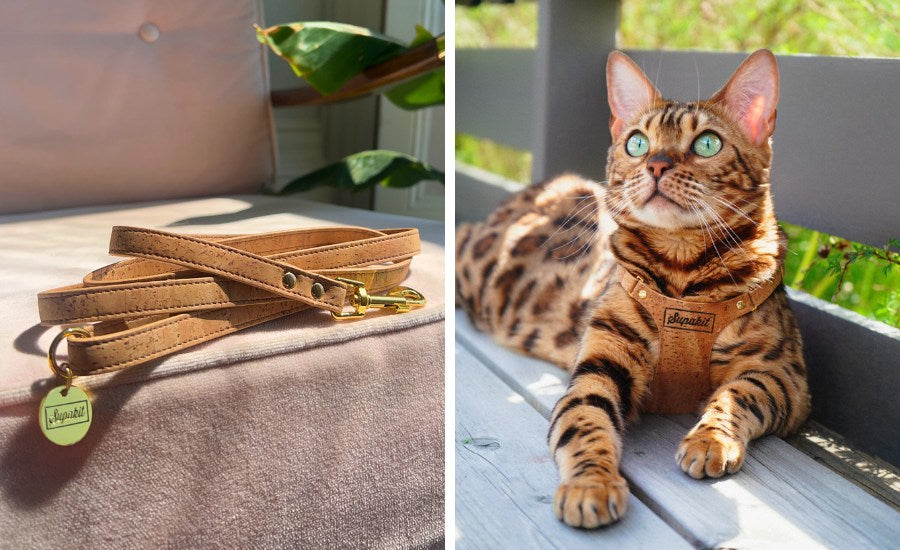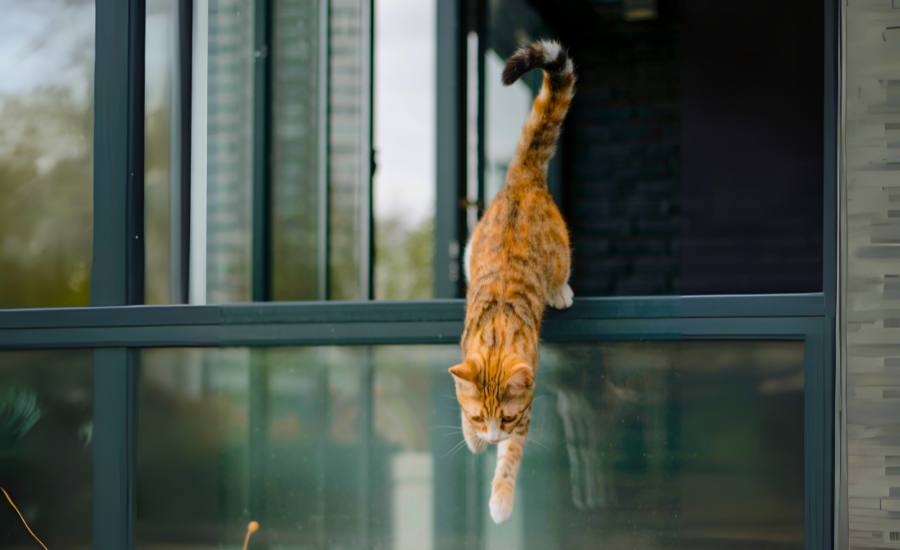How To Introduce Cats
Introducing a new cat to your home is an exciting but delicate process. When you already have a cat in residence, introducing them carefully will help build a positive relationship between them. Creating a successful multi-cat home is possible, but takes patience and understanding. Let’s find out how to set yourself up for success when introducing cats.
The Importance Of Introducing Cats To Each Other Slowly
Unlike dogs, whose ancestors lived in wolf packs with complex social structures, our domestic kitties are descendants of the solitary wildcat (1). As a result, cats lack the friendly body language that dogs evolved to build relationships with their pack members. When new cats meet, there are no friendly tail wags or rollovers (2). The warmest greeting is to ignore the newcomer and not stare.
Like their wildcat ancestors, cats are also highly territorial and protective of resources such as food, water, and shelter (3). Because of this, your resident cat will not view your new pet as a welcome addition to the family, but as an intruder and rival in his territory. Luckily, there are steps you can take to make it more likely that they will accept one another and live peacefully together.
1. Consider Whether Introducing A New Cat Is A Good Idea

Before deciding to bring a new cat into your home, there are many factors to consider. These factors include the temperament of your existing cat and the suitability of your living situation.
Let’s take a closer look at some questions we need to ask ourselves before we get a new kitty. The more you can answer yes, the more likely it is that you will have success when introducing a new cat.
Is Your Cat Female?
Female cats are generally more likely to be accepting of newcomers than males. This is especially true if the new cat is also female. Male pairs are less likely to get along peacefully after being introduced as adults.
If the new cat is female and an immediate relative of your existing female cat, they might even become close friends. Feral cats have been seen to cohabit naturally (2), when daughters are allowed to remain in their mother’s territory. They sometimes live together and share the burden of kitten-rearing the new generations.
Is Your Cat Neutered/Spayed?
A neutered male cat will not experience the same drives to mate or to drive away sexual competitors as an unneutered cat. Therefore, neutering a male cat significantly reduces aggression (4). Similarly, a spayed female won’t produce sexual hormones, go into heat, or yowl to elicit mating. This means that introducing neutered/spayed cats is much easier.
Is Your Cat Younger Than 6 Months Old?
Cats that grow up together are more likely to remain friends once they reach adulthood. Historically, this was only seen between related females. However, thanks to early neutering, lasting bonds can now also be maintained between males and male-female pairs of pet cats.
If you hope to keep multiple cats together, introducing a new cat should be done as early as possible. The ideal situation is to select littermates and avoid the need for introductions altogether. When this is not possible, try to select two cats of similar age, introduce them young, and neuter them early for the best chance of success.
Has Your Cat Lived With Other Cats Before?
If your cat has lived with another cat before and gotten along well with them, then they will be used to sharing their household. This is a promising sign that they might accept a newcomer. However, it is not a guarantee.
Has Your Cat Had Positive Experiences With Other Cats Before?
Even if your cat hasn’t lived with another cat before, chances are you’ve seen them interacting with other cats at some point. For example, if you have ever taken your cat to stay at a cattery, your cat will have been able to see and smell other cats nearby. If your cat was not particularly reactive to this, then this is a positive sign that they may be accepting of new cats.
Were The Parents Of Your Cat Friendly To Other Cats?
“Friendliness” in cats has been shown to be an inheritable trait (5). This means that the temperament of the parents of your resident kitty could have a big influence on how successful introducing a new cat will be.
Find out as much as you can about how the parents of your cat behave toward other cats. In some cases, such as with a rescue cat, this might be more difficult, or even impossible. Still, it is worth asking the staff at the shelter, or the private breeder of your kittens, for any information they might be able to share with you.
Do You Have Spaces In Your Home Where The Cats Could Avoid Each Other?
Research shows that peacefully-coexisting cats have clear claims over rooms and areas in their houses (6). The best sunspots and beds are even timeshared on a respected schedule!
If your home is very small, or has an open-plan arrangement such as a studio apartment, then the cats will struggle to give each other space. This could lead to building stress and tension.
An ideal multi-cat home has enough room for each cat to enjoy their personal space, without their territory being crossed by other kitties. If you can provide this, you will have a much better chance of successfully introducing a new cat to your home.
Can You Provide Each Cat With Food, Water, And A Litter Tray In Separated Locations?
Cats are very defensive of resources such as food, water, and shelter. Wild cats use territories as well as a solitary lifestyle to avoid conflicts over resources. In your home, your cats may compete for the food bowl, litter tray, or best cushion. To avoid conflict, your cats will need separated sets of resources that they don’t have to share. If possible, place each cat’s resources in their own territory.
2. Prepare Your Home For Introducing A New Cat Successfully

When you bring your new cat home, they will need to be isolated from your other cat for up to 2 weeks. If your resident cat usually has free-range outdoor access, you may want to keep them indoors during the introduction process. This will remove the risk of your resident cat moving away from home in response to the new kitty.
How To Prepare The New Cat’s Isolation Room
The room that you set aside for the newcomer to inhabit should be one that you can avoid disturbing too often. Before you can work on introducing your cats to one another, you need to get the new cat comfortable with your home, and with you. The new cat will be nervous at first.
In the isolation room, provide all the resources the new cat will need:
- Food bowl
- Water bowl
- Litter tray
- Bedding
- Toys
- Scratching post
It is important not to reuse items that belonged to your resident cat. They will be clearly marked with your resident cat’s smell. This could be very intimidating for the new cat in these early days. Instead, you can enjoy the thrill of going to the pet store and picking out a full range of accessories for your new cat.
If possible, bring some toys, bedding, and used litter substrate from your new cat’s previous home. Place these in the appropriate places in the isolation room. The presence of his own scent in this alien environment will help him to get settled, as well as to locate the bathroom.
In preparation for the later stages of introduction, work out how you could install a mesh barrier in the doorway of the quarantine room. Double-height baby-gates with netting attached can work well. Once you begin to introduce the new cat to your resident cat, this see-through, smell-through barrier will be extremely useful.
3. How To Introduce Cats Successfully In Steps

Planning and supervising the first few encounters between your resident cat and your new cat can seem tiresome, but is well worth the effort. It is much easier to set your cats up for successful cohabitation than it is to mend a bad relationship resulting from a traumatic introduction.
Initially, you will need to bring the new cat into the prepared isolation room without the resident cat seeing. Leave the new cat to settle in with minimal disturbance, and try to keep the resident cat away from the area outside the door. Don’t yet try to make any kind of introductions while your new cat is getting used to this alien environment.
Give Each Cat A Small Item With The Scent Of The Other
Once your new cat has spent a few days settling into the isolation room with only his own scent and the fresh accessories, it’s time to gradually bring in new smells.
Start small. First, try petting one cat with a small fabric item of yours, such as a glove or handkerchief. Pay close attention to the head and neck of your cat, as this is where they have scent glands for communication. Then, offer the scented item to the other cat. Put it somewhere unchallenging or innocuous, such as on the floor somewhere. Don’t put it in their bed or by their food. Do this for both cats.
It’s important to watch each cat’s reaction to the scented item. A good response would be to smell the item, and then ignore it. An amazing response would be to smell it and then rub on it or play with it. These responses give you a good indication that the cat is likely to accept the other.
A negative response would be to hiss at the item, puff up the fur and turn side on to the item, or run away and hide from the item. These responses suggest that the cat is highly reactive to the presence of the other and may struggle to calmly accept them in the home. This does not mean they won’t be able to get along, but it will certainly take more patience to get to that stage. Take the item away and try again later.
Increase The Presence Of The Other Cat’s Smell In Their Territory
Once you have tried the above step a few times and are getting either a neutral or positive reaction, you can increase the scent crossover. Slowly bring bigger scented items into the room, or try placing them where the other cat might lay on them, such as in the bed.
Watch for the same signs as before. At this stage, we are hoping to create a mixture of smells that the cats are comfortable with. This will be the scent of you, and the scent of each other, on a cushion for example.
Mark The House With The Combined Scent
Once both cats are comfortable with the presence of items that smell like the other in their spaces, it’s on to the next step. Take an item that has been lain on by both cats. The combined smell that is now covering this item will be very useful. Use the item to mark the house with this community smell, by rubbing it at cat height around sofas, stairs, and walls. Don’t rub it on any resources like eating areas.
What we have done at this stage is to make the cats feel as if they already live together, despite not seeing each other anywhere. It may take a little while for them to get used to this. But, after a little while of smelling the marks and encountering no negative consequences, they should start to feel safe and relaxed.
Let The Cats Meet For The First Time
The next step is to let them see one another, but in a way that they can’t physically touch. Remember that, unlike dogs, cats don’t have social cues to show “friendliness” to a strange cat. There is only staring aggressively, or politely ignoring the stranger. For this reason, it is best not to give them a chance to approach one another and end up in a face-off.
You will need at least one person per cat to help out at this stage. While your new cat is in their room and your resident cat is outside, engage their attention with toys and treats. Then, begin to open the door so that they can see each other through the barrier.
If they lock eyes, try to distract their gaze immediately. A great outcome would be for them to remain relaxed, while stealing little glimpses at each other. Treating and playing with them will keep their attention on you and help create positive associations with the presence of the other cat.
But, don’t get overconfident here. It is much better to have a very short, positive session, than a longer one that ended badly. You can always repeat this exercise later, so end it on a high for now.
Let The Cats Get To Know Each Other
Once you’ve practised this exercise a few times, you can begin to give the cats a bit more freedom. If they want to move closer to investigate each other, let them do that. However, if you see any warning signs, distract them and close the door when you can. Try not to restrain them if possible.
Over time, you can increase the time that the door is open. Invite them to play closer to one another. Eventually, you will be able to remove the screen during a session. Reward the cats for positive behaviour and replace the screen. Again, increase the time that they are in contact in small increments, until they have unknowingly graduated to cohabiting the house!
Warning Signs When Introducing Cats

As we discussed above, cats don’t really have any positive communication that they use to greet strange cats. However, they have plenty of signs to show that they are afraid, uncomfortable, or gearing up to fight. If you see any of these during an introduction session, you should try to distract the cats, separate them, and end the session for now.
- Laying low to the floor
- Staring intently
- Hiding
- Running away
- Tail swishing sharply back and forth
- Turning side on and arching their back
- Fluffing up, especially in the tail, which can turn into a huge bottlebrush
- Hissing
- Raising the front paw with claws outstretched
- Moving in to bite or make other physical contact
In the next introduction session, increase the distance between them. You can also increase the value of the treats and toys that you are using as a distraction. Enlist the help of an extra person. Lastly, end the session as soon as you have a positive result, even if it was very short.
Positive Signs Of Friendship When Introducing Cats

Cats do have some signs for acknowledging cats they have a friendly or at least courteous bond with. They would not show these signs to a stranger, but may begin to offer them to each other as their comfort level grows.
- Never staring into each other's eyes
- Raising the tail straight up as they approach each other (without fluffing up the fur)
- Greeting by touching noses
- Rubbing cheeks on one another
- Rubbing the side of their bodies along one another
- Resting close together, or even touching
- Mutual grooming of one another, most likely behind the ears
If you begin to see these signs then congratulations! You have successfully introduced your new cat to your home.
How To Introduce A New Kitten To An Older Cat

The steps for introducing a kitten to an older cat are very similar to the process we already discussed. However, there are a few extra things to bear in mind.
While in isolation, your kitten will need a lot more attention and supervision from you. Unlike an adult cat, who might prefer to be left alone to settle in, a new kitten will be looking for littermates to play with and may be restless.
Also, you will need to supervise much more closely after you introduce a new kitten to a cat. Young, boisterous kittens can annoy older cats, which could cause a breakdown in their relationship. Though it seems counterintuitive, if you have an older cat it can be better to introduce two kittens rather than one into your home. That way, they can play with each other instead of annoying your resident cat.
References
- Bradshaw, J. W. S. (2006). The Evolutionary Basis for the Feeding Behavior of Domestic Dogs (Canis familiaris) and Cats (Felis catus). In The Journal of Nutrition (Vol. 136, Issue 7, pp. 1927S-1931S). Oxford University Press (OUP). https://doi.org/10.1093/jn/136.7.1927s
- Bradshaw, J. W. S. (2016). Sociality in cats: A comparative review. In Journal of Veterinary Behavior (Vol. 11, pp. 113–124). Elsevier BV. https://doi.org/10.1016/j.jveb.2015.09.004
- Crowell-Davis, S. L., Curtis, T. M., & Knowles, R. J. (2004). Social organization in the cat: A modern understanding. In Journal of Feline Medicine and Surgery (Vol. 6, Issue 1, pp. 19–28). SAGE Publications. https://doi.org/10.1016/j.jfms.2003.09.013
- Root Kustritz, M. (2012). Effects of Surgical Sterilization on Canine and Feline Health and on Society. In Reproduction in Domestic Animals (Vol. 47, pp. 214–222). Wiley. https://doi.org/10.1111/j.1439-0531.2012.02078.x
- McCune, S. (1995). The impact of paternity and early socialisation on the development of cats’ behaviour to people and novel objects. In Applied Animal Behaviour Science (Vol. 45, Issues 1–2, pp. 109–124). Elsevier BV. https://doi.org/10.1016/0168-1591(95)00603-p
- The Domestic Cat: The Biology of Its Behaviour, Third Edition. Publisher: Cambridge University Press, Editors: Dennis Turner, Patrick Bateson







